
Compilation Album
Jimmie Haskell "Sing A Song With The Beatles
(Instrumental Background Re-Creations Of Their Big Hits)" (CP-7260)
(Update: 4th. July 2022)



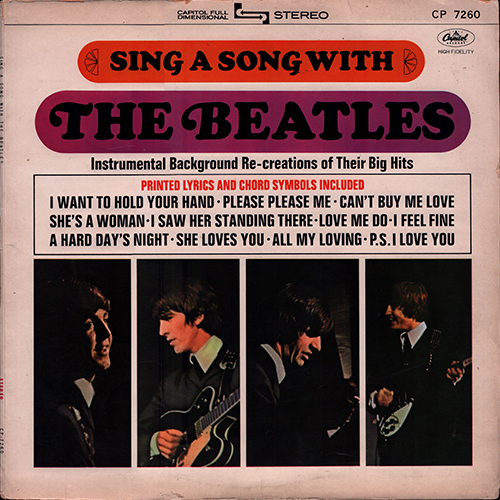 Capitol 1st. Sleeve |
About
Jimmie Haskell Jimmie Haskell-Composer/Arranger/Conductor/Music Producer of Chords, Inc.-is a musical icon known throughout the world. Jimmie was born in the New York City area or NY and moved to Los Angeles, CA when he was just nine years old. Playing gigs in studios around Los Angeles and nightclubs on the Sunset Strip in Hollywood was the beginning of his renowned musical career. He played the accordion for a band called "The Bachelors". Jimmie was the Composer, Music Supervisor, Musical Director, Music Conductor, Music Arranger and/or Orchestrator of approximately 31 films, 32 TV movies and 445 TV episodes. He has also worked with over 20 symphony orchestras and numerous broadway shows. Throughout his career, Jimmie received 3 Grammy Awards, 1 Primetime Emmy Award, 2 Primetime Emmy Award Nominations and other awards. He composed, arranged, conducted and/or produced over 135 Gold and Platinum albums. He his also the winner of 3 Clio Awards, 2 Addy Awards and 1 Cable Car Award. He currently lives in the Orange County area with his lovely wife, Barbara Haskell, and is still composing, arranging, conducting and producing music at his studio. (from "Jimmie Haskell Web site") |
| INDEX |
| TITLE | Sing A Song With
The Beatles (Instrumental Background Re-Creations Of Their Big Hits) |
||||
| CATALOG NUMBER | CP-7260 |
||||
| RELEASE DATE | 15th. August 1965? / First Press | ||||
| TRACK LISTING | SIDE 1 | SIDE 2 | |||
| A Hard Day's Night |
I Feel Fine | ||||
| I Saw Her Standing There |
P.S. I Love You |
||||
| Love Me Do |
Cant Buy Me Love |
||||
| She Loves You |
All My Lovin' |
||||
| Please Please Me |
I Want To Hold Your Hand | ||||
| She's A Woman | |||||
| FRONT --> Click! | BACK --> Click! | SIDE 1 --> Click! | SIDE 2 --> Click! | DISK | |
 |
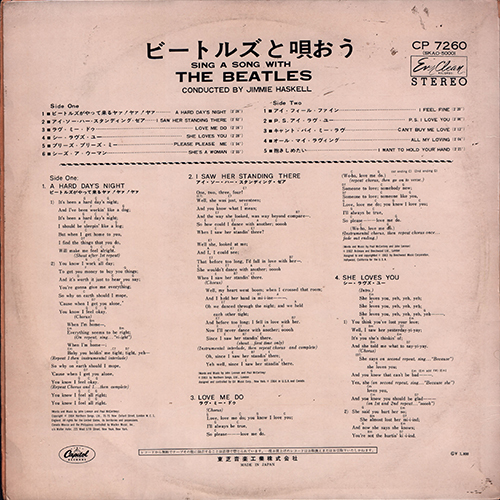 |
 |
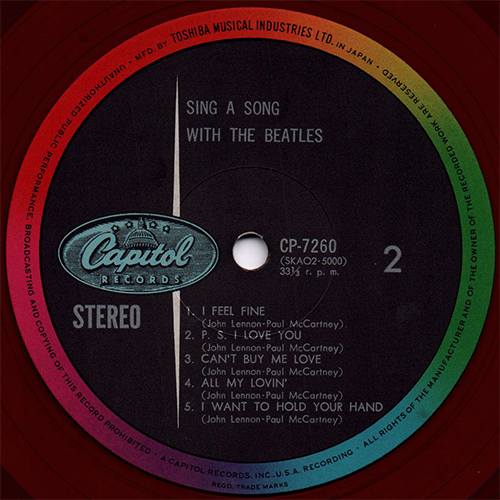 |
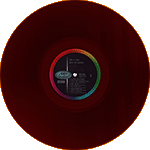 |
|
| INSIDE --> Click! | INNER SLEEVE | ||||
| FRONT --> Click! | BACK --> Click! | The original color "advert" inner bag has a fold-over flap at the top of the bag to prevent the record from falling out. | |||
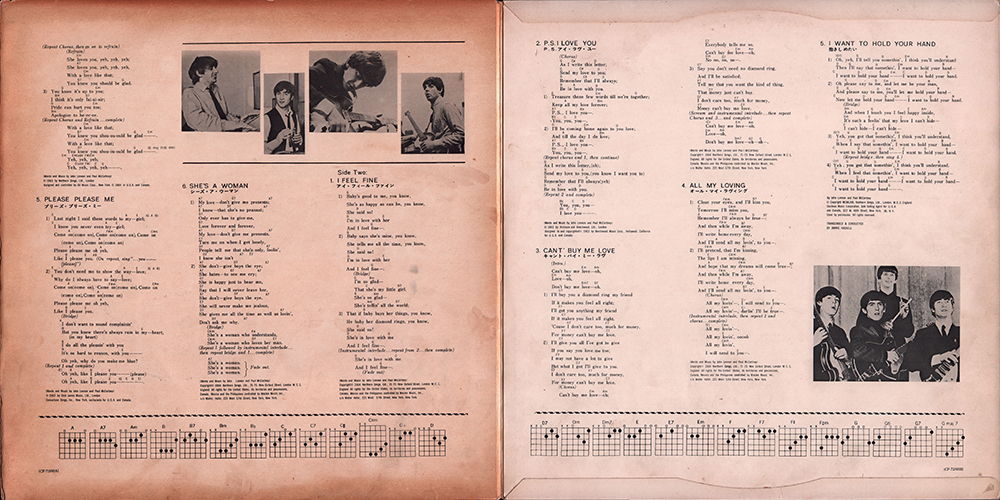 |
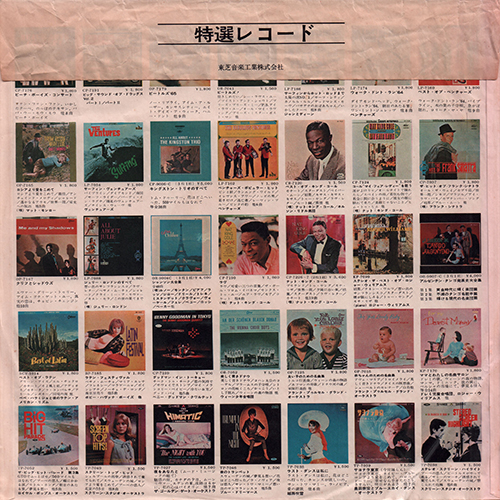 |
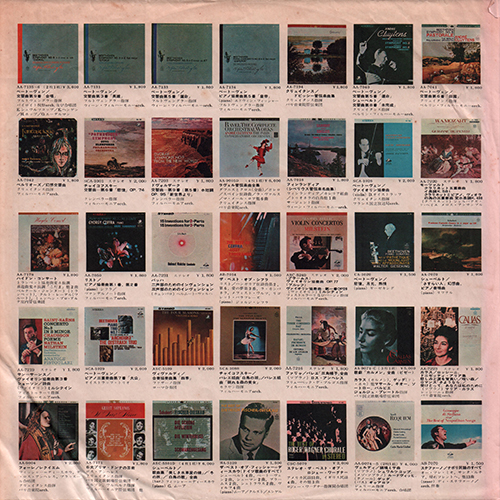 |
|||
| INNER SLEEVE CLOSE UP | FRONT COVER CLOSE UP | ||||
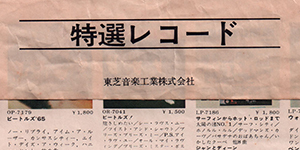 |
The words "Special Selection Records" was printed in black. | 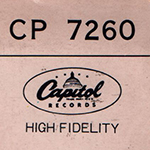 |
Catalogue number "CP 7260", Capitol logo mark, and the word "HIGH FIDELITY"were printed at the upper right corner of the front cover. | ||
| FRONT COVER CLOSE UP | |||||
 |
The front cover slicks has the "Capitol Full Demensional Stereo" arrow logo at the top. | ||||
| BACK COVER CLOSE UP | |||||
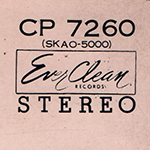 |
Catalogue number "CP 7260", EverClean logo mark, and the word "STEREO"were printed at the upper right corner of the back cover. |  |
|||
| "Toshiba Musical Industries Ltd." and "MADE IN JAPAN" were printed at the bottom of the back cover. | |||||
| BACK COVER CLOSE UP | |||||
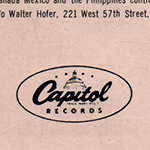 |
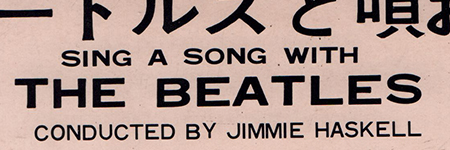 |
 |
|||
| "G ¥ 1,800" was printed at the left corner of
the back cover. |
|||||
| BACK COVER AND INSIDE CLOSE UP | |||||
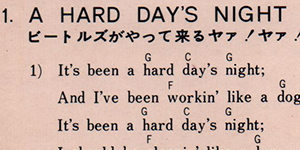 |
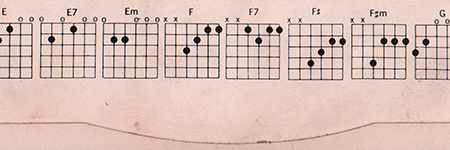 |
||||
| Gatefold type. Full laminated
soft cover. flipback cover. Guitar chords and lyrics were printed on the inside of the cover. |
|||||
| Light
Blue OBI CLOSE UP |
|||||
| 1st. pressing had a light blue /
white OBI and priced ¥1,800 on obi strip. Capitol logo mark
and catalog number "CP-7260" were printed on the front. There is no order sheet on the back side of the Obi. "Toshiba Musical Industries Ltd." was printed on the strip. (Sorry, I don't have it.) |
|||||
| LABEL CLOSE UP | |||||
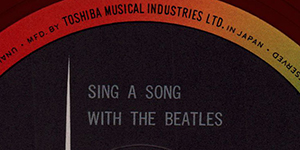 |
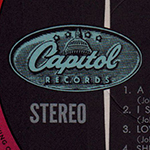 |
Capitol Black
label with color band. The words "MFD. BY TOSHIBA MUSICAL INDUSTRIES LTD. IN JAPAN" was printed at the perimeter. |
|||
| LABEL CLOSE UP |
|||||
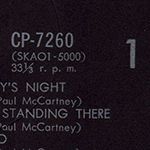 |
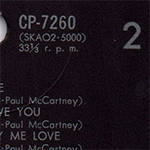 |
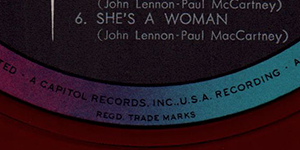 |
The words "A CAPITOL RECORDS, INC., U.S.A. RECORDING" was printed at the perimeter. | ||
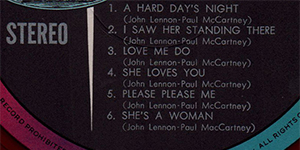 |
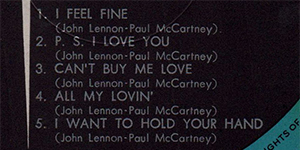 |
Instrumental Background e-Creations Of Their
Big Hits |
|||
|
OTHER ITEM
|
|||||
| - |
|||||
| RECORD LABEL | Capitol Black label with color band | ||||
| MIX | STEREO |
||||
| MATRIX No. | SIDE 1 | SKAO1 - 5000 4 |
|||
| SIDE 2 | SKAO2 - 5000 3 |
||||
| PRESS MARK |
5G |
||||
| VINYL COLOR | RED | ||||
| RECORD COMPANY'S NAME | SLEEVE |
Toshiba Ongaku
kogyo Kabusikigaisha |
|||
| LABEL |
MFD. BY TOSHIBA MUSICAL INDUSTRIES
LTD. IN JAPAN |
||||
| SYMBOL/PRICE | G ¥1,800 |
||||
| LYRIC SHEET STYLE | - |
||||
| COVER FORM | Gatefold type. Full laminated soft cover. flipback cover. |
||||
| INNER SLEEVE |
The original colour "advert" inner bag
Type-3 |
||||
| OBI | Green
/ white so called "Odeon Arrow" OBI |
||||
| COVER DESIGN/ PHOTO/ NOTES | Liner notes: Yoshiji Kizaki (*) | ||||
|
COMMENTS
|
in 1965, Toshiba
release in Japan, instrumental backgrounds, gatefold cover
with Obi. Capitol Black label with color band / Red wax. The words "MFD. BY TOSHIBA MUSICAL INDUSTRIES LTD. IN JAPAN" was printed at the perimeter. In spite of the cover photos and titling which make this look like an official Beatles release, this is not The Beatles at all. The LP was made by a group of Tower (US Capitol subsidiary) studio musicians conducted by Jimmie Haskell; the music was also transcribed by Jimmie Haskell. The listener is asked to sing along to the instrumental backing and the lead vocal part is handled by an organ ( perhaps EARLY KARAOKE !). This was the first LP release on Tower in the US. The obi: "Light blue" Obi It is light blue / white in design with light blue background with the half circle on top. It also features an Odeon logo, catalogue number and price information. While most Japanese records feature local music, a lot of music fans there like foreign music, as well. The language barrier in Japan presented a problem – should foreign album covers be changed for Japanese albums? The solution was the obi, which means “belt” or “sash”. The obi is a strip of paper, usually about two inches wide, that wraps vertically around the album cover, containing information about the artist and album in Japanese. As these strips of paper were fragile and easily torn, they are often missing, especially since consumers in the 1950s and 1960s attached little significance to them. Finding Japanese records made prior to 1970 that still have the obi intact can be quite difficult, and for some albums, nearly impossible. The inclusion of the obi can dramatically affect the price of some Japanese records, sometimes increasing the price by a factor of ten. While usually found in a wraparound strip, there are other versions of the obi that have occasionally been used. In the early 1960s, a short-lived hankake obi, or “half obi” was used. These were small strips of paper that simply folded over the top of the cover. These were problematic for retailers, as they tended to easily fall off of the record. |
||||
